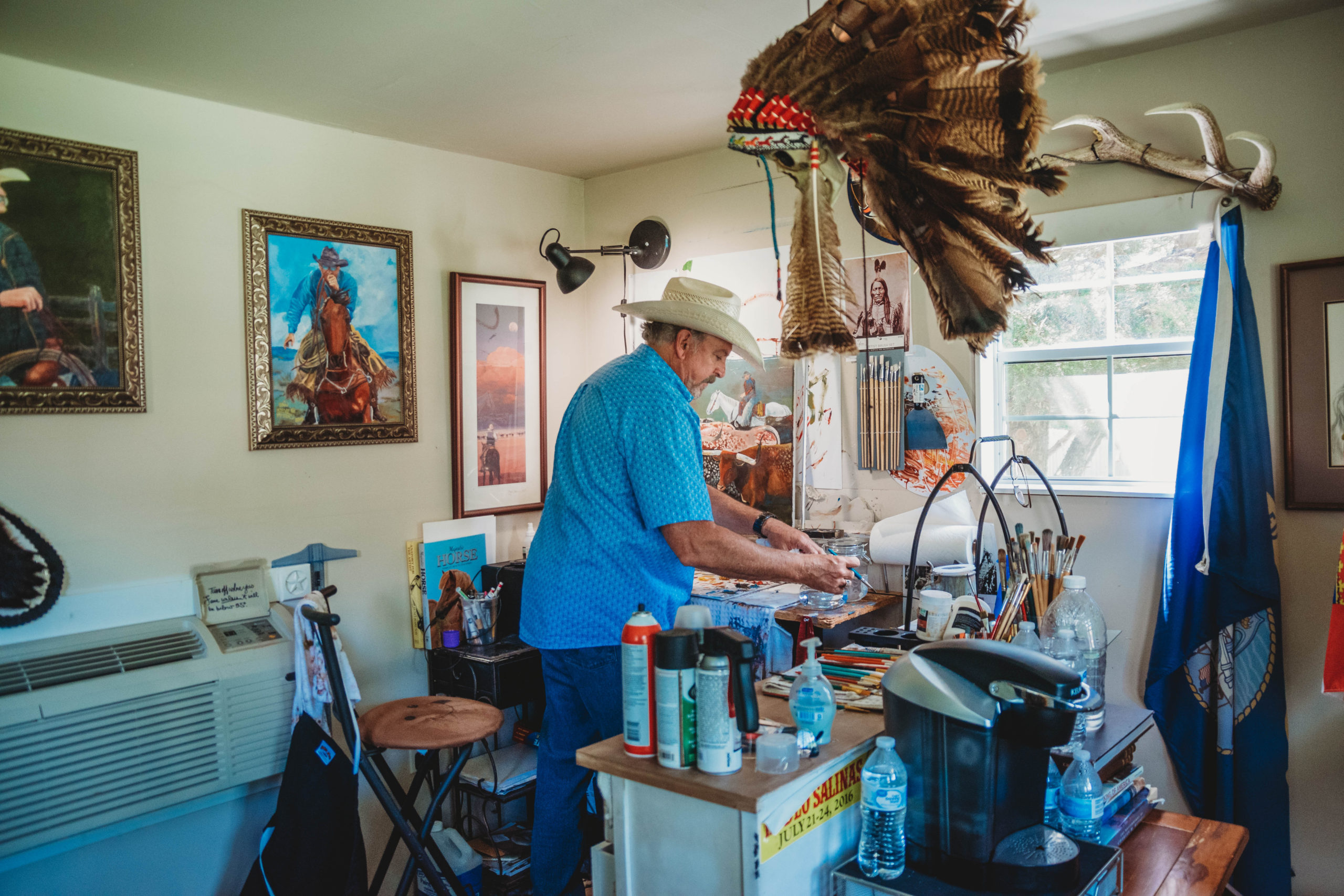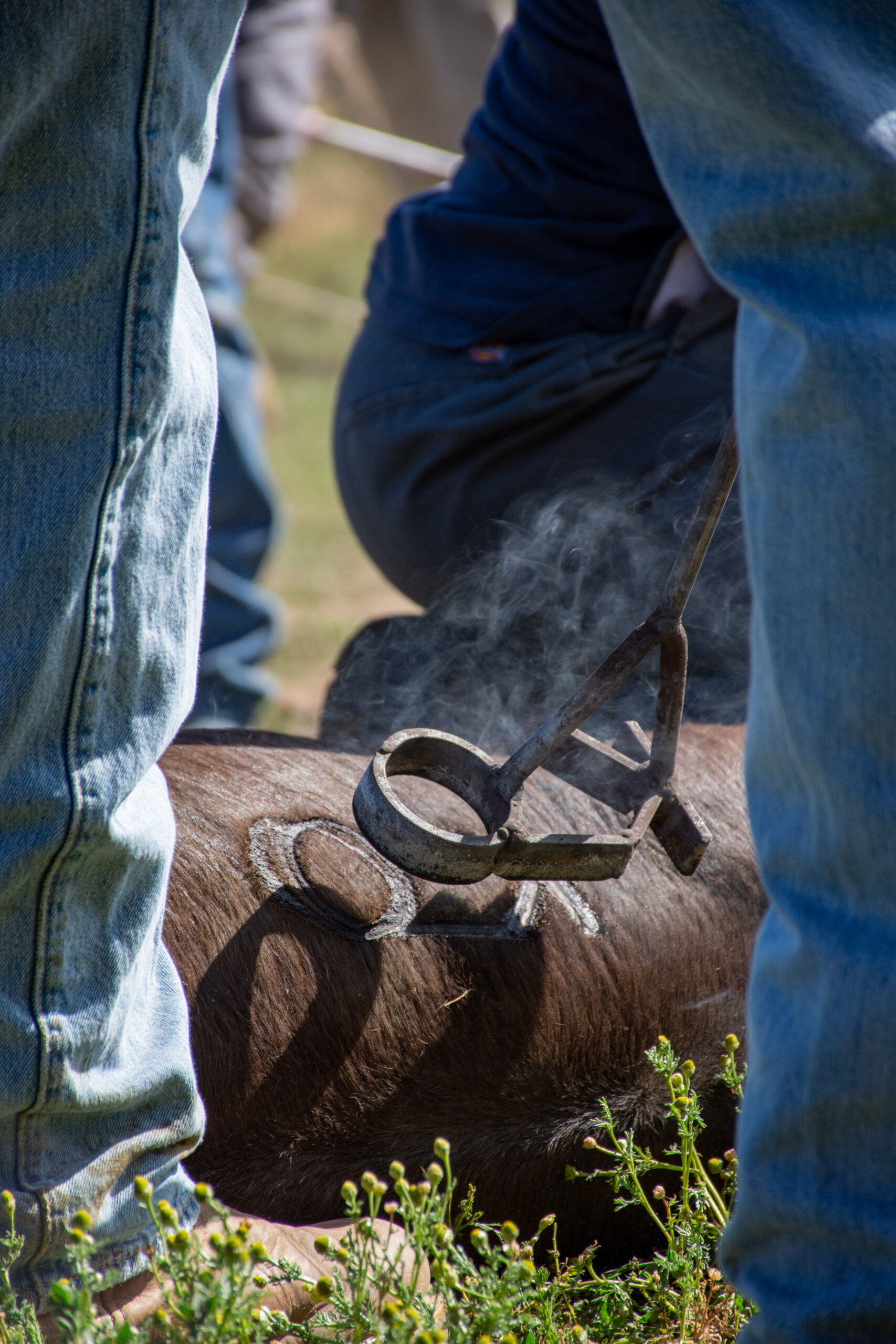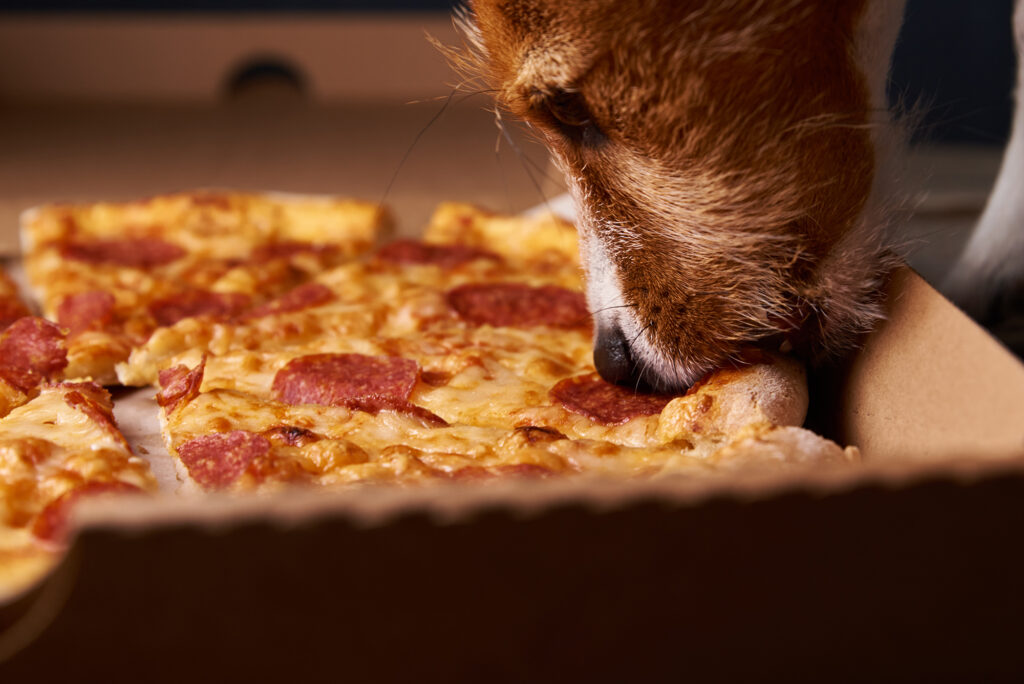Country Lifestyle
Finishing the Story – Steve Miller

Strong arms and broad shoulders belie the image of a simple artist. Hands, while soft enough to make the most minute change to a delicate clay leg, have also fell towering trees. Guthrie’s Steve Miller wasn’t raised to be an artist or a successful salesman, but he became both. As a storyteller, recounting the narrative behind his art, he can’t be beat. Most things he says deserve quotation marks.
Miller grew up as a fourth-generation logger in Kalispell, Montana, more accurately, the Flathead Valley. His earliest memories were of long days and even harder work. “Most people in the western industry don’t know that about me. I felled timber, set chokers, skidded logs, and loaded and drove logging trucks. I could do anything in that world and was a pretty good hand,” he shared. “It was just what you did. I always tell people that know me now that it was like being born in a coal mining town in the Appalachians.”
Every summer vacation from the seventh grade on, Miller would do a man’s job in the woods with his father. The day he graduated high school, he applied and was hired for a job at a sawmill.
Still, he always gravitated towards art. “I have loved it since I was a little kid. I would look at mountain scenery, at the deer, the elk, the horses, and I would always think, ‘How do you make that with a brush? How do you paint that? How do you get that color?’” He added, “Like all young artists, that’s what I wanted to do, but I had to go to work. I’ve worked my whole life and my art was always pushed to the back as a hobby, because I got into careers I owed a lot of time to, and there was not enough time left over.”
While he recalls the work ethic he learned in his early years and his love of art, he remembers no aspirations of a better life. “You were just a logger. You didn’t have a choice, or, better said, you didn’t think of having a choice. There were no plans for higher education; you simply needed to get out of school and go to work. I’m lucky I finished high school, because there was that mentality, not only in the Valley, but even in my family, that you just quit school and go to work,” he shared.
Looking back from where he is now, Miller contemplates how different life could have been. “I can’t believe how short-sighted I was. I take full responsibility for that. I had no clue in my 20s that I could have gone to college or that there was a whole different layer to the world,” he said.
While a death-defying experience with grievous injuries doesn’t sound like a positive, Miller is adamant that an accident just prior to his 30th birthday was just that. “The best thing that ever happened to me was when I had a logging accident where a tree fell on me. I should have been killed, but I was limbing a big tree, and the one that fell on me knocked me off of that tree down to the ground. It landed on the big tree, and if I would have been limbing a smaller one, it probably wouldn’t have ended as well,” he said.
The resulting broken back led to unemployment. “I couldn’t go back to work in the woods. I was on food stamps and had two kids to support. I remember thinking, ‘What the hell am I going to do?’” he recalled.
In a twist of fate, Miller met a friend of his father’s who’d heard of his bad luck. The man offered to teach Miller how to be an audiometric technician. “That basically means you sell and fit hearing aids. I didn’t have a college degree, but he told me I didn’t have to, I just had to work under his supervision for a year,” Miller said.
It only took a week of work for Miller to realize he had a talent for sales. Just two years later he had worked up to being the Regional Manager of the Miracle Ear Hearing Aid Company and was one of the top 12 sales representatives in the nation.
A few years after that, the National Sales Director job came open, and Miller applied. “I’ll be darned if I didn’t get the promotion,” he laughed. Soon he was living in Minneapolis, working out of a corner office on the seventh floor. While his career was thriving, Miller himself was dying on the vine.
“I’m a team roper. I grew up in the country, but my horse was 50 miles away in a stable and I never got time to ride him. I took a Western Horseman magazine with me to work one day, made a list of every company that I might want to work for, wrote up a resume, and sent it out,” he said. “I got a call from Montana Silversmiths back in my home state. I interviewed for the job and got it.”
Miller has worked for Montana Silversmiths for nearly 30 years. He started his career as the Vice President of National Sales and Marketing. While he’s handed over the reins for most of his duties, he’s still an Ambassador at Large for the company. “I think my biggest claim-to-fame there is that I put together one of the best sales rep forces in the industry, so much so that I was approached by other major western industry companies to help with their sales staff,” he shared.
The Art
Miller never pursued art as a career, but he couldn’t help indulging in his hobby. “I can’t even tell you how many pictures I’ve given away. Drawings, paintings, you name it,” he laughed. If you find him sitting still for more than a minute, he’s likely roughing something out. “I’ve spent several long conference calls doing sketches.”
He had no formal training in art, but if he begins to question his ability, he reminds himself of Charlie Russell, a well-known American artist of the old American West. “Charlie Russell never had a lesson in his life, and he was able to do it. He’s my hero. I have read everything about him and know the names of most of his paintings. I was actually born on the same date he died, just different years, of course. I always say I hope I got a little piece of him,” Miller shared.
For a long time, he wondered where his artistic streak had come from, but he recently found out that it came from his mother’s side of the family. “That family is Norwegian. My great grandfather came here from Norway in 1904. Because of social media, I’ve been in touch with that side of the family, and they all make their living as artists in tv, film, and painting,” he shared. “My son, Jason, is a better artist than I’ll ever be, really, so we got that from somewhere.”
Miller began with acrylics, but found his talent lay in oil painting. “I feel like it’s easier for me to paint with and is much richer. My son got me into sculpting. I picked up some clay he sent me and took some coat hangers and bent them up for armatures, and started doing some sculpting, and wound up making more money on my sculptures than my paintings,” he said.
He did his first sculpture in the early 1990s, and by later in the decade, his hobby and his work finally collided. Montana Silversmiths was hoping to expand into the lifestyle sector. “They wanted to do sculptures that could be sold through Western stores at a reasonable price so that anyone could own a gallery quality sculpture for their home,” he shared. “Instead of paying $10,000 for a bronze, they could buy a resin one for $200. It wound up being a very successful line.”
Miller began working on the sculptures, which became the Steve Miller line that he called “My Vision of the West.” The series consisted of nine pieces, concentrating primarily on the people and times of the mid- to late 1800s. “It’s how I see the west. But the west as we know it started with the discovery of the New World. The first Europeans entered a new land, a land that to them seemed an empty wilderness to be settled and tamed.
“But the land they saw as empty wilderness was not empty, and it certainly would not tame easily. This land was home to many tribes, languages, and cultures of people. These were an innocent and primitive people, open, and even helpful to the culture that would soon overwhelm them. These were a people who did not work iron, copper, or steel, nor did they know of the wheel, or write their language. But they did know the land and how to live off its bounty. It provided all they needed, and they left it as they found it, unscarred and flourishing with animal life of every kind. The meeting of these two cultures would soon become a violent collision,” Miller explained.
“Of Stone and Steel” was the first in the line, showing a lone Indian curiously tapping his arrow against the railroad tracks; something strange that appeared during his time away from home. “I have no idea where the ideas come from. I just saw something and wonder what it would be like to be this young man. You see, this man was a Cheyenne, but the territory stretches from southern Nebraska up to Montana. These kids would go visit relatives far away for a few years to find a wife before heading home. What would it be like for him to go find a wife, start riding home, and then there is this monstrous looking snake crossing the prairie? What would he be thinking?
“I’d just be thinking about that, and then pretty soon I’d doodle a picture and then make a sculpture,” he shared.
That same thought process took him through the entire line. The remaining pieces were named His New Winchester, The Highest Price for Beef, When Beef Was Wild, When Cowboys Take a Dare, the Houlihan, the Crossing, When A Woman Knew Her Place, and Sittin’ Pretty.
The title of the artwork is important to Miller. “The stories behind the artwork make the piece, and I always said you can’t have a piece of artwork unless the title can tell you the story,” he shared. “It’s important to me that my work allows people to finish the story for themselves. The person looking at it has to decide how each of those stories end. For example, in the Highest Price for Beef the horse and rider are falling in the middle of this stampede. What happens? Does the cowboy pay the highest price? In the Crossing, does the rider make it to the other shore, or the distant shore?”
While the Steve Miller collection was exceptionally popular, selling out quickly, his most prized work did not make him a dime. He did a series of sculptures of three Cheyenne warriors killed in the Battle of Little Bighorn, which was commissioned by the tribe to raise money to mark the Cheyenne deaths on the battlefield.
“The Cheyenne don’t refer to it as Custer’s Battle. They refer to it as the Battle of Greasy Grass. That battle, outside of Napoleon’s Battle of Waterloo, is the most written about battle in history. When I started the sculptures, the only marker on the battlefield for a Native American was because a soldier had documented where he had fallen,” Miller said.
The three Native Americans Miller portrayed were Lame Whiteman, Limber Hand, and Noisy Walking, and all three men still have living relatives. “I roped with Dennis Limberhand, and that’s how I knew they were wanting to do this project. I made the sculptures, gave them to Dennis, and he took them to the tribal council,” he shared.
As with most of his works, Miller engrossed himself in the project. He shared the story of Noisy Walking. “He was a 14-year-old boy. His relatives told me he would have had four braids, because he hadn’t been in war yet. You can see he has a stake with a loop on it, and that’s because he was an Undefeated Warrior. The Native American’s don’t have a name for a Suicide Warrior, like we would call it. When the battle started, they were required to put that loop around their ankle and drive the stake into the ground. The only way they could retreat was if another warrior pulled the stake or they were killed. The night before the battle, him and about 14 other young men took the undefeated pact, not knowing there would be a battle the next morning,” he shared. He learned that Noisy Walking would have been armed only with a bow and arrow, and his sculpture reflects that.
He spent an incredible amount of time researching each man, then donated all his work, including foundry costs for the originals and molds. “They were trying to raise money to put markers on the battlefield, so it wasn’t something to make a profit on. It’s the work I’m proudest of,” he said. “I was able to help the Cheyenne Indians put markers on the battlefield where their family members died.”
In addition, Miller created the Miss Rodeo America pageant’s perpetual award and did a bronze of Bodacious with his son, both sculptures are in the ProRodeo Hall of Fame. He also created the bronze sculptures given to the Head and Heel Horses of the Bob Feist Invitational each year.
These days, Miller is focusing on his oil paintings, spending his time perfecting his technique. “I found I really enjoy doing portraits in oil and special projects for people, instead of just painting a picture and hoping someone likes it. I love doing commissioned work.”
Learn more about Steve and his art in the August 2020 issue of Oklahoma Farm & Ranch.
Country Lifestyle
Riding for the Brand

By: Christopher Dysinger
According to the Code of the West a man who has integrity is one who rides for the brand. If you are unfamiliar with cowboy parlance this phrase is used to describe being loyal to the outfit you work for. Cowboys were, “intensely loyal to the outfit they were working for and would fight to the death for it. They would follow their wagon boss through hell and never complain.” -Teddy Blue Abbot. Riding for the brand means being loyal and when I consider what it means to be loyal I am reminded of the words of the Lord Jesus to His disciples in Matthew 16:24, “Then said Jesus unto His disciples, If any man will come after Me, let him deny himself, and take up his cross and follow Me.” To me, to take up the cross and follow the Lord is the epitome of what it means to ride for the brand.
When you place your trust in the Lord Jesus you are signing on to His outfit, to speak the language of the West. When you called upon the name of the Lord Jesus by faith, He saved you and from this point you are riding for His brand. In taking up your cross and following Him you have pledged to be loyal, and this means you face any hardship or trial like a cowboy on the trail moving the herd. Any complaint must be swallowed in the same way you would swallow a cup of coffee. When I hear our faith and loyalty to the Lord Jesus put into these terms it stirs something within me that moves me to keep right on riding for the brand.
Louis L’amour wrote, “Riding for the brand was an expression of loyalty to a man’s employer or the particular outfit he rode for. It was considered a compliment of the highest order in an almost feudal society. If a man didn’t like a ranch or the way they conducted their affairs he was free to quit, and many did; but if he stayed, he gave loyalty and expected it. A man was rarely judged by his past only by his actions. Many a man who came west left things behind him he would rather forget, so it was not the custom to ask questions. Much was forgiven if a man had courage and integrity and if he did his job. If a man gave less than his best, somebody always had to pick up the slack, and he was not admired.” It is the same when a person gives his or her heart to Jesus.
When you come to the Lord Jesus you are not judged by your past. When you come to the Lord Jesus, repenting of sin and seeking forgiveness, everything from your past is left behind. All will be forgiven. 1 John 1:9 reads, “If we confess our sins, He is faithful and just to forgive us our sins, and to cleanse us from all unrighteousness.” When you place your faith in the Lord Jesus you are promising to be loyal and in return you will receive the same. He has promised that He will never leave us or forsake us. When you walk with the Lord Jesus through life you are indeed, “riding for the brand.”
“Riding for the brand” is not just an expression of loyalty nor is it just an expression of pride, it is also an expression of love. When a cowboy claims to be riding for the brand, he is telling any other outfit who may seek his loyalty, that he cannot give it, because he has given his word to another. It is the same when we pledge our faith and loyalty to the Lord Jesus. If any would call us away from Christ we cannot go, because we are riding for the brand.
The End
This article is an excerpt from the book, The Bible and the Code of the West by Dr. Christopher Dysinger.
Country Lifestyle
Farm Dogs & Table Scraps

What’s Safe and What’s Not?
Growing up on a farm, our dogs were tough. They roamed the pastures, slept under the barn, and ate just about anything they could get their paws on—whether we meant for them to or not. I’ll admit, I never thought twice when one of our old cow dogs snatched a biscuit off the table or licked up a spill from the barn floor. I’ve even seen a dog steal a whole rib bone off a plate and trot off like he’d won the lottery. And somehow, they always seemed fine.
But here’s the thing—just because they survived doesn’t mean it was safe. For every farm dog that lucked out, there’s another that wasn’t so fortunate. Some human foods can be downright toxic to dogs, and a little bit of bad luck (or a smaller, more sensitive dog) can turn a harmless snack into an emergency.
Common toxic foods lying around the farmhouse
If you’ve got a farm dog—or any dog, really—you need to be aware of the dangers lurking in everyday foods. Some of the biggest culprits include:
Chocolate – The darker it is, the worse it is. Even a little can cause vomiting, seizures, or worse.
Grapes & Raisins – No one’s exactly sure why, but they can cause kidney failure fast.
Onions & Garlic – In large enough amounts, these can destroy red blood cells, leading to anemia.
Xylitol (Found in Sugar-Free Gum & Candy) – This artificial sweetener can send a dog’s blood sugar crashing and cause liver failure.
Alcohol – Even small amounts can be deadly to dogs, affecting their nervous system much more than it does ours.
Bones from Cooked Meat – While not necessarily toxic, they can splinter and cause serious internal injuries.
Macadamia Nuts – These can lead to weakness, vomiting, and even paralysis in dogs.
What to do if your dog eats something toxic
First, don’t panic—but don’t ignore it either. If you know your dog ate something dangerous, call your vet immediately. They can tell you whether to induce vomiting or if it’s something that requires urgent care. If it’s after hours, contact the ASPCA Animal Poison Control Center (888-426-4435) or the Pet Poison Helpline (855-764-7661).
Prevention is always the best medicine, so keep toxic foods out of reach. That might mean keeping the trash can secured, making sure kids don’t slip the dog a treat under the table, or just being more mindful of what’s left on the counter.
Our farm dogs might have been lucky, but luck isn’t a great strategy when it comes to their health. A little awareness goes a long way in making sure they stay happy, healthy, and ready for the next day’s work.
For more information
ASPCA Animal Poison Control: www.aspca.org/pet-care/animal-poison-control
Pet Poison Helpline: www.petpoisonhelpline.com
Visit www.akc.org/expert-advice/nutrition/foods-your-dog-should-never-eat
Country Lifestyle
Summer Squash and Corn Chowder

By Lacey Vilhauer
Total time: 40 minutes
Servings: 6-7
Ingredients
- 6 slices bacon, cooked and crumbled and 1 1/2 Tbsp rendered bacon fat reserved
- 1 1/2 lbs yellow squash, chopped (about 3 medium)
- 2/3 cup thinly sliced celery
- 1 cup diced onion
- 1 Tbsp flour
- 2 cloves garlic, minced
- 2 3/4 cup milk (I used 1%)
- 5 cups canned or fresh cut corn (from about 6 ears corn), divided
- 1/2 cup heavy cream
- 1 1/2 tsp chopped fresh thyme (or 1/2 tsp dried)
- 3/4 tsp salt, then more to taste
- 1/4 tsp freshly ground black pepper, then more to taste if desired
- 3/4 cup shredded cheddar cheese, for serving
- Chopped green onion for garnish (optional)
Instructions
Heat 4 tsp reserved bacon fat in a large pot over medium-high heat. Add celery and onion and sauté 2 minutes then add the squash.
Saute until tender, about 6 minutes, adding in garlic and flour during last 2 minutes of sauteing. Reduce heat slightly.
Add 1 1/2 cups milk, 2 cups of the corn, thyme, salt and pepper to the sauteed veggies.
To a blender add remaining 3 cups of corn, remaining 1 1/4 cups milk and the cream. Process in blender until nearly smooth (about 30 seconds).
Add pureed mixture to pot and stir to blend. Cook until mixture reaches a light boil.
Serve warm with shredded cheese, crumbled bacon and sliced green onions if desired.
-

 Attractions8 years ago
Attractions8 years ago48 Hours in Atoka Remembered
-

 Country Lifestyle11 months ago
Country Lifestyle11 months agoJuly 2017 Profile: J.W. Hart
-

 Country Lifestyle9 years ago
Country Lifestyle9 years agoThe House a Treasure Built
-

 Country Lifestyle4 years ago
Country Lifestyle4 years agoThe Two Sides of Colten Jesse
-

 Outdoors7 years ago
Outdoors7 years agoGrazing Oklahoma: Honey Locust
-

 Equine8 years ago
Equine8 years agoUmbilical Hernia
-

 Outdoors5 years ago
Outdoors5 years agoPecan Production Information: Online Resources for Growers
-

 Farm & Ranch7 years ago
Farm & Ranch7 years agoHackberry (Celtis spp.)





